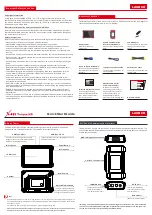
Measurement of Small-current Signals – Measurement System Model and Physical Limitations
76
For an
R
m
of 10
7
Ω, an error < 1% demands that
R
in
must be greater than 10
9
Ω. PC-board leakage, relay
leakage, and measurement-device characteristics lower
R
in
below the desired value of infinity.
A similar problem is the finite input-leakage current
I
in
into the voltage-measuring circuit. It can be leakage
directly into the input of the voltage meter, or leakage from a voltage source (such as a power supply) through
an insulation resistance into the input. If an insulator connected to the input has a resistance of 10
12
Ω between
+15 V and the input, the leakage current is 15 pA. Fortunately, most sources of leakage current are DC and
can be tuned out in impedance measurements. As a general rule, the DC leakage should not exceed the
measured AC signal by more than a factor of 10.
The Reference 3000 uses an input amplifier with an input current of around 5 pA. Other circuit components
may also contribute leakage currents. You therefore cannot make absolute current measurements of very low
pA currents with the Reference 3000. In practice, the input current is approximately constant, so current
differences or AC current levels of less than one pA can usually be measured.
Voltage Noise and DC Measurements
Often the current signal measured by a potentiostat shows noise that is not the fault of the current-
measurement circuits. This is especially true when you are making DC measurements. The cause of the current
noise is noise in the voltage applied to the cell.
Assume that you have a working electrode with a capacitance of 40 µF. This could be represented by a 1 cm
2
polished bare metal immersed in an electrolyte solution. A rough estimate of the capacitance of the electrical
double-layer formed by a metal/electrolyte interface is 20 µF/cm
2
. The area is the microscopic area of the
surface, which is larger than the macroscopic geometric area, because even a polished surface is rough. The
impedance of this 40
F electrode, assuming ideal capacitive behavior, is given by:
Z
= 1/
j
C
At 60 Hz, the impedance magnitude is about 66
.
Apply an ideal DC potential across this ideal capacitor and you get no DC current.
Unfortunately, all potentiostats have noise in the applied voltage. This noise comes from the instrument itself
and from external sources. In many cases, the predominant noise frequency is the AC power-line (mains)
frequency.
Assume a realistic noise voltage,
V
n
, of 10 µV (this is lower than the noise-level of most commercial
potentiostats). Further, assume that this noise voltage is at the North American power-line (mains) frequency of
60 Hz. The noise voltage creates a current across the cell capacitance:
I
=
V
n
/
Z
10 × 10
–6
/66
150 nA
This rather large noise current prevents accurate DC current measurement in the low nA or pA ranges.
In an EIS measurement, you apply an AC excitation voltage that is much bigger than the typical noise voltage,
so this is not a significant problem.
Shunt Resistance and Capacitance
Non-ideal shunt resistance and capacitance arise in both the cell and the potentiostat. Both can cause
significant measurement errors.
Parallel metal surfaces form a capacitor. The capacitance rises as the metal’s area increases and as the
separation distance between the metals decreases.
Wire and electrode placement have a large effect on shunt capacitance. If the clip leads connecting to the
working and reference electrodes are close together, they can form a significant shunt capacitor. Values of 1 to
10 pF are common. This shunt capacitance cannot be distinguished from “real” capacitance in the cell. If you
are measuring a paint film with a 100 pF capacitance, 5 pF of shunt capacitance is a very significant error.
Shunt resistance in the cell arises because of imperfect insulators. No material is a perfect insulator (infinite
resistance). Even PTFE, which is one of the best insulators known, has a bulk resistivity of about 10
12
Ω·m.
















































